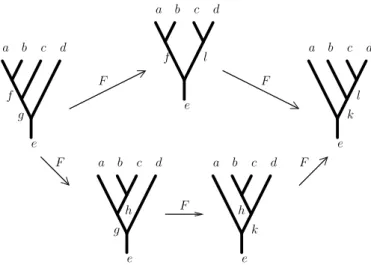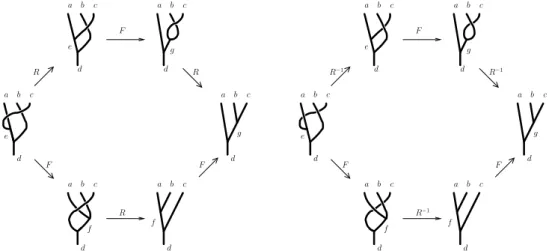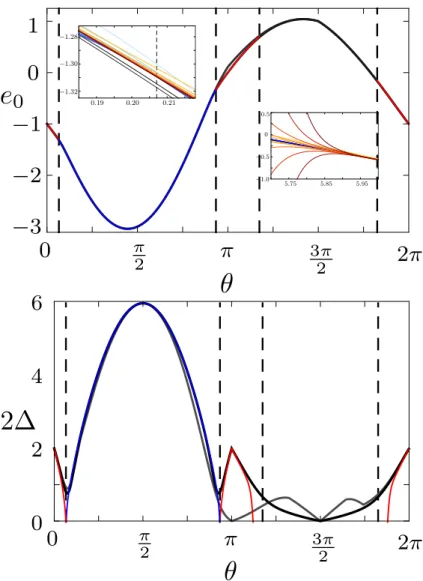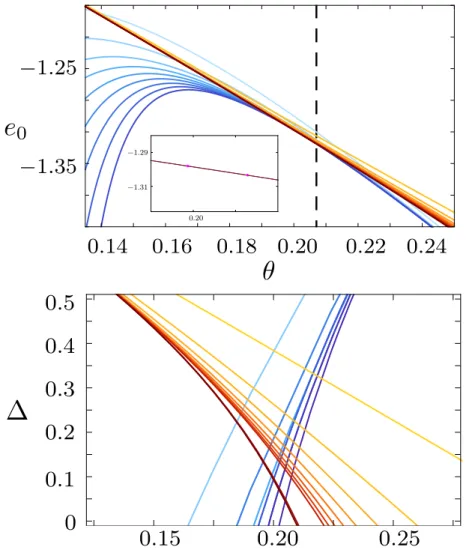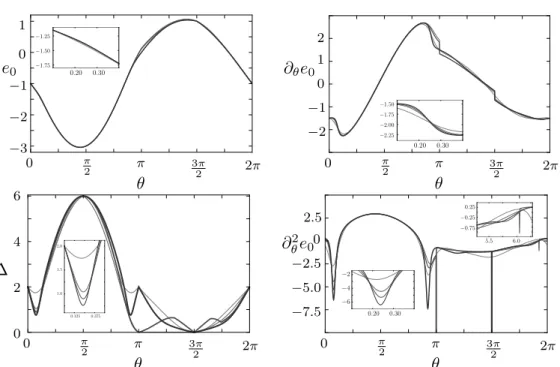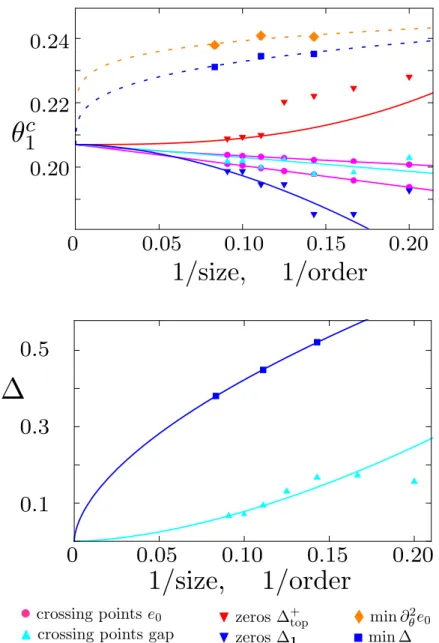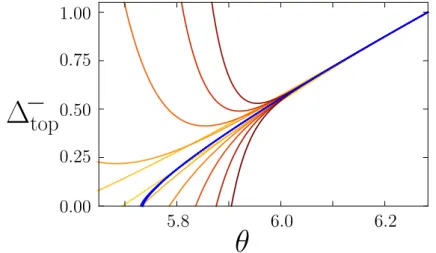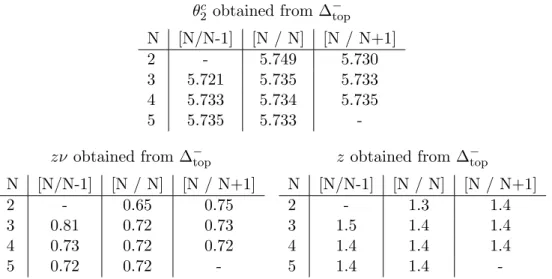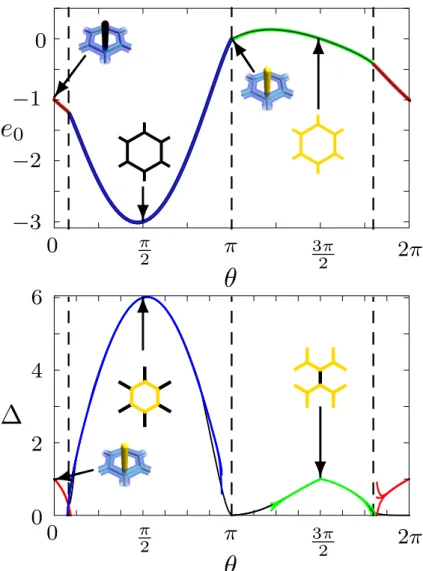non-Abelian anyons
Dissertation
zur Erlangung des Grades eines Doktors der Naturwissenschaften der Fakult¨ at Physik der Technischen Universit¨ at Dortmund
Th` ese de doctorat
pour obtenir le grade de Docteur de l’Universit´ e Pierre & Marie Curie
Marc Daniel Schulz
Date of defense: 19.12.2013
Members of thesis committee: Dr. Kai P. SCHMIDT (thesis advisor) Dr. Julien VIDAL (thesis advisor)
Prof. Philippe LECHEMINANT (referee) Prof. Joachim STOLZE (referee)
Prof. Simon TREBST (referee)
Dr. Benoˆıt DOUC ¸ OT (examiner)
Dr. Carsten RAAS (examiner)
Prof. Bernhard SPAAN (examiner)
We study quantum phase transitions and the critical behavior of topologically-ordered phases by considering various string-net models perturbed by local operators defined on the two-dimensional honeycomb lattice. More precisely, by means of high-order series expansions in combination with exact diagonalization, we analyze the phase transitions induced by the analogue of a magnetic field for the topologically-ordered phases de- scribed by doubled semion, Fibonacci, and Ising theories. We develop a quasi-particle picture of the elementary anyonic excitations for all these models. The effective models of interacting quasi-particles allow us to determine the respective phase diagrams and to analyze spectral properties of the low-energy physics. Our analysis of the low-energy spectrum leads to the first evidence of continuous quantum phase transitions out of topologically-ordered phases harboring non-Abelian anyons.
Wir untersuchen Phasen¨ uberg¨ ange und das kritische Verhalten topologisch geordneter Phasen unter Einfluss von lokalen St¨ orungen anhand verschiedener String-Net-Modelle, die auf dem zweidimensionalen Bienenwabengitter definiert sind. Mittels verschiedener Hochordnungsreihenentwicklungen und exakter Diagonalisierung werden Phasen¨ uber- g¨ ange zwischen verschiedenen topologisch geordneten und topologisch trivialen Phasen untersucht. Die hier betrachteten topologisch geordneten Phasen werden jeweils durch achirale Semion–, Fibonacci– und Ising–Feldtheorien beschrieben. Zur Betrachtung der gest¨ orten String-Net-Modelle, entwickeln wir eine Quasiteilchenbeschreibung der jeweili- gen elementaren anyonischen Anregungen. Diese effektiven Modelle wechselwirkender Quasiteilchen erm¨ oglichen eine Analyse des Niederenergiespektrums und damit auch eine Bestimmung der kritischen Eigenschaften von auftretenden Phasen¨ uberg¨ angen. Un- sere Untersuchung liefert erste Anzeichen f¨ ur kontinuierliche Phasen¨ uberg¨ ange zwischen topologisch geordneten Phasen, deren elementare Anregungen fraktionale, nicht abelsche Statistik aufweisen, und topologisch trivialen Phasen.
Nous ´ etudions les transitions de phases et le comportement critique de syst` emes topo- logiquement ordonn´ es en consid´ erant diff´ erents mod` eles de string-nets en pr´ esence d’une perturbation locale. Plus pr´ ecis´ ement, en utilisant ` a la fois des th´ eories de perturbations
`
a des ordres ´ elev´ es ainsi que des diagonalisations exactes, nous analysons les transitions
induites par l’´ equivalent d’un champ magn´ etique pour des th´ eories d’anyons de type
Fibonacci, Ising, et semionique et d´ eveloppons une image de type quasiparticules pour
les excitations ´ elementaires. Les mod` eles effectifs de quasiparticules anyoniques en in-
teraction nous permettent de d´ eterminer les diagrammes de phase pour chacune de ces
th´ eories et d’analyser les propri´ et´ es spectrales de basses ´ energies. Ces ´ etudes nous con-
duisent ` a mettre en ´ evidence de transitions de phase quantiques continues dans des
syst` emes topologiquement ordonn´ es en pr´ esence d’anyons non-Ab´ eliens.
1 Introduction 1
I Phase transitions in perturbed string-net models 9
2 Anyons 11
2.1 Quantum mechanics in two dimensions . . . 11
2.2 Algebraic theory of anyons . . . 13
2.2.1 Fusion . . . 13
2.2.2 Braiding . . . 17
2.2.3 Twists and spins . . . 18
2.2.4 Modular S-matrix . . . 19
2.3 Doubling of a theory . . . 19
2.4 List of theories . . . 20
2.4.1 Semions . . . 21
2.4.2 Fibonacci . . . 22
2.4.3 Ising . . . 22
2.4.4 Toric Code . . . 23
2.5 Chapter Summary . . . 23
3 String-net models 25 3.1 The Levin-Wen Hamiltonian H
LW. . . 25
3.1.1 String-net Hamiltonian H
SN. . . 26
3.1.2 The fat-lattice visualization . . . 28
3.1.3 The flux operator B
p. . . 30
3.1.4 The dual basis . . . 34
3.1.5 Properties of the eigenstates . . . 41
3.1.6 Brief summary for the string-net Hamiltonian . . . 43
3.2 The local Hamiltonian H
loc. . . 44
3.3 The perturbed string-net Hamiltonian . . . 46
3.4 Realizing different boundary conditions . . . 46
3.4.1 The ladder . . . 47
3.4.2 Open boundary conditions . . . 49
3.5 Realizations of the different anyonic theories . . . 49
3.5.1 The golden string net: Fibonacci anyons . . . 50
3.5.1.1 The topological phase . . . 50
3.5.1.2 Counting of states . . . 51
v
3.5.1.3 The flux-full case . . . 53
3.5.1.4 The 1-phase . . . 53
3.5.1.5 The τ -phase . . . 53
3.5.2 Ising anyons . . . 54
3.5.2.1 The topological phase . . . 55
3.5.2.2 Counting of states . . . 55
3.5.2.3 The flux-full case . . . 57
3.5.2.4 The 1-phase . . . 57
3.5.2.5 The dimer limit . . . 57
3.5.3 The Abelian cases: semions and D( Z
2) . . . 58
3.6 Chapter Summary . . . 61
4 Topological symmetry breaking 63 4.1 General framework . . . 64
4.1.1 Condensation . . . 65
4.1.2 Confinement . . . 66
4.2 Examples of topological symmetry breaking . . . 67
4.2.1 Phase transitions out of the doubled semion phase D(Semion) . . . 67
4.2.2 Phase transitions out of the doubled Fibonacci phase D(Fib) . . . 68
4.2.3 Phase transitions out of the doubled Ising phase D(Ising) . . . 68
4.3 Chapter summary . . . 70
5 Results for perturbed string-net models 73 5.1 Phase transitions in the semion model . . . 75
5.1.1 Phase transition between topological and 1-phase . . . 77
5.1.2 Phase transition between topological and AFM-phase . . . 84
5.1.3 Summary of the phase transitions in the semion model . . . 86
5.2 Phase transitions for Fibonacci anyons . . . 87
5.2.1 Phase transition between topological and 1-phase . . . 87
5.2.2 Phase transition between topological and τ -phase . . . 93
5.2.3 Phase transition between 1- and τ -phase . . . 96
5.2.4 Summary of the phase transitions in the Fibonacci model . . . 97
5.3 Phase transitions for Ising anyons . . . 98
5.3.1 The valence-bond crystal . . . 100
5.3.2 Phase transition between topological and 1-phase . . . 101
5.3.3 Phase transition between topological and the VBC . . . 105
5.3.4 Summary of the phase transitions in the Ising model . . . 106
5.4 Comparison between the different models . . . 107
5.5 Chapter Summary . . . 109
II Series expansion techniques for perturbed string-net models 111 6 Methodology 113 6.1 Series expansions . . . 114
6.1.1 Perturbative continuous unitary transformations . . . 115
6.1.1.1 Continuous unitary transformations . . . 115
6.1.1.2 Perturbative continuous unitary transformations . . . 117
6.1.1.3 Cluster additivity . . . 121
6.1.1.4 Linked-Cluster Theorem . . . 122
6.1.2 Degenerate perturbation theory . . . 124
6.1.3 Partition technique . . . 127
6.1.4 Efficient perturbation theory . . . 130
6.1.5 Perturbation theory in the thermodynamic limit . . . 133
6.1.6 Extrapolations . . . 134
6.2 Exact diagonalization . . . 137
6.3 Chapter summary . . . 140
7 Implementation of the series expansion 141 7.1 General considerations . . . 141
7.2 Implementation for the topological phase . . . 143
7.2.1 Implementation of the scalar product . . . 146
7.2.2 Removing the redundancy . . . 147
7.2.3 Implementation details of the calculations . . . 150
7.3 The non-topological phases . . . 150
7.3.1 Implementation in the 1-phase . . . 150
7.3.2 Implementation of the τ-phase in the Fibonacci theory . . . 153
7.4 Chapter Summary . . . 154
8 Linked-cluster expansion 155 8.1 Graph decomposition in the topological phase . . . 157
8.2 Graph expansions for non-topological phases . . . 167
8.2.1 Graph expansions in the 1-phase . . . 167
8.2.2 Graph expansions in the τ -phase . . . 172
8.3 Chapter Summary . . . 174
9 Summary and Outlook 177 A Series expansions for the semion model 180 A.1 Series expansions for the topological phase . . . 180
A.2 Series expansions for the 1-phase . . . 184
B Series expansions for Fibonacci anyons 185 B.1 Series expansions for the topological phase . . . 185
B.2 Series expansions for the 1-phase . . . 188
B.3 Series expansions for the τ -phase . . . 189
C Series expansions for Ising Anyons 199 C.1 Series expansions for the topological phase . . . 199
C.2 Series expansions for the 1-phase . . . 204
Bibliography 207
Declaration of Authorship 217
Acknowledgements 218
Chapter 1
Introduction
The secret of getting ahead is getting started.
- Mark Twain -
The main goal of modern physics is to describe and understand the various states of matter found in nature, ranging from large scales as the evolution of the universe in cosmology down to the subatomic scales of the constituting particles of matter and light in high-energy physics. In condensed-matter physics, the classification of the various phases emerging due to strong correlation effects is at the heart of current investigations.
One can characterize the different phases of matter by considering an order parameter.
Any order parameter is linked to a symmetry, which is present for a given phase. Of particular importance are local order parameters as these can be related e.g. to (broken) spatial symmetries, which are of relevance in the study of condensed-matter systems, or to local-gauge symmetries essential for electrodynamics. A well-known example for a local order parameter is the magnetization of a ferromagnet.
A deeper understanding of the characteristics of a phase arises when transitions between different phases are studied. In the case of a continuous transition between two phases described by a local order parameter, the behavior of the system at the transition point does not depend on its local details but only on the symmetries characterizing the two phases. The quantities showing this universal scaling behavior are accessible either by experiments or by theoretical descriptions and thus allow to determine the symmetries involved for a given system. The corresponding theoretical framework of spontaneous symmetry breaking was developed by Landau in the 1930’s [1, 2]. It has been successfully applied to many fields of physics since then. In our discussion, we shall restrict ourselves to quantum phase transitions, which are not governed by thermal fluctuations but purely by quantum fluctuations. Therefore, we consider only the case of zero temperature in the following.
1
In the 1980’s, the discovery of the fractional quantum Hall effect [3, 4] in the two- dimensional electron gas yielded the first example of a system, which is not described by local order parameters, since different phases are not distinguishable by a local symme- try. Soon, possible connections to the phenomenology of high-temperature superconduc- tors were pointed out [5, 6]. These findings triggered the emergence of a classification scheme invoking non-local properties and thus going beyond the Landau paradigm. This classification is the so-called topological order [7, 8].
One can characterize topological order in several ways. A formal description of topo- logically-ordered systems is given by topological quantum field theory [9–11]. However, the lack of a local order parameter can also be seen as a defining property for topological order [12–14]. According to the latter definition, we refer to a system in the thermo- dynamic limit with a spectral gap above the ground state(s) {|gs
αi} as topologically ordered if we have for any operator O with bounded support
hgs
α| O gs
β= c δ
α,β, (1.1)
where the constant c does not depend on the particular state |gs
αi. Thus, there is no local operator acting non-trivially within the ground-state manifold. However, topo- logically ordered phases can still be characterized by non-local order parameters. The corresponding quantities can, for example, be the expectation value of Wilson-loop op- erators on the scales of the system size [15] or properties of the topological field theory as the modular S-matrix [16].
Topological order manifests itself in different ways. One hallmark is that the ground- state degeneracy of a system depends on the topology, in which it is embedded [8]. Also, measures of the long-range entanglement such as the so-called topological entanglement entropy can witness topological order [17, 18]. The framework of topological symmetry breaking [19] has been developed in order to allow for a description of continuous phase transitions in analogy to spontaneous symmetry breaking. Let us note that although topological order allows to classify phases without local order parameters and topological symmetry breaking explains how some phase transitions between different topologically ordered phases may occur, this framework does not provide an answer to the question whether the universal properties emerging in spontaneous symmetry breaking carry over to topological phase transitions or not.
The interest in topologically ordered systems even further increased after it has been
realized that the excitations have exotic exchange statistics in two dimensions [20, 21],
i.e. they do not behave as bosons or fermions. It was Wilczek, who named excitations
with exotic exchange statistics as anyons [22]. This fractional statistics was later on
found to be intimately related to topological order [23]. There are two types of anyons.
When two Abelian anyons are exchanged, the wave function acquires a phase factor similar to the case of bosons and fermions, whereas the exchange of non-Abelian anyons represents a non-trivial unitary transformation in the corresponding Hilbert space. The latter implies in particular that the excited states are not uniquely specified by the po- sition of the quasi-particles. These exotic particles are expected to exist in fractional quantum Hall states, e.g. the so-called Fibonacci anyons appear in the theoretical de- scription of the fractional quantum Hall state for filling fraction ν = 12/5 [24], and there is even recent experimental evidence for the so-called Ising anyons to be the elementary excitations of the corresponding state at filling fraction ν = 5/2 [25–27].
Topological order switched from the stage of a purely academic interest to the focus of eventual application after it was realized that the absence of a local order parameter is equivalent to the fact that local perturbations cannot induce decoherence in topologically ordered systems [28, 29]. Thus topologically ordered systems are a suitable platform for decoherence-free quantum computation. The degenerate ground-state manifold can be used to store a quantum state, whereas the non-Abelian exchange statistics allows for the implementation of different operations [30–33]. The fact that non-Abelian anyons can be used to implement quantum computation underlines their more complex struc- ture compared to Abelian anyons, which lack this feature. In the context of quantum information, the investigation of phase transitions out of a topologically ordered phase is, in some sense, equivalent to study the robustness of a topological quantum computer.
Let us mention that there are related phases of matter that attracted interest in recent years: the so-called symmetry-protected topological order shares a lot of features with the topological order we discussed above. In particular, topological invariants character- ize both families of states. Prominent examples of the symmetry-protected topologically ordered states are the so-called topological insulators [34, 35]. The most important dis- tinction between these two classes of phases is the presence of symmetries, which allow to classify and understand the various symmetry-protected topological-orders [36–40]. In contrast to topological ordered phases, symmetry protected topologically ordered states display only short-range entanglement [41]. Nevertheless, these phases harbor anyons as boundary modes (e.g. the so-called Majorana mode in one-dimensional wires [42, 43]), which yield promising candidates for the experimental implementation of topological quantum computation [44, 45].
The models available to study topological-ordered phases can be divided into two fam-
ilies. The first consists of models, in which the topological excitations emerge from
more conventional microscopic (e.g. spin) degrees of freedom. To this family belong the
Heisenberg models and extensions on frustrated lattices [46], quantum loop gases [47],
and quantum dimer models [48–50]. However, the latter models do mostly support only
Abelian anyons as the emergence of non-Abelian statistics requires in most cases either non-local interactions between the microscopic degrees of freedom [51] or a modification of properties of the Hilbert space [52].
1These possibilities are already built in for the second family of models as their micro- scopic degrees of freedom are already given in terms of anyons. The most prominent representants of this family are the lattice-gauge models [54, 55], including the celebrated toric code [28]. Also, the string-net picture [56–59] provides models realizing topological order, which will be the main focus of this thesis. These models are likely not realized in a condensed-matter system due to their fine-tuned multi-spin interactions, but serve as playground to investigate fundamental properties of topologically ordered phases.
Especially in one spatial dimension, the investigation of the latter type of models also for those harboring non-Abelian anyons is very successful, as one can often either identify integrable models [60–63] or one is able to perform accurate numerical studies to find the corresponding critical theory [64–68] for phase transitions driven by anyon interactions.
Also the effect of local perturbations on non-Abelian anyons has been considered [69, 70].
However, when it comes to the investigation of phase transitions in two dimensions, considerably less is known. This is on the one hand due to the lack of analytical and numerical tools and on the other hand due to the existence of only a few exactly solvable models, which serve as a suitable starting point. Nevertheless, there are numerical works approaching the limit of two dimensions by considering quasi-one dimensional ladder systems [67, 71, 72].
One of the exactly solvable models is the toric code [28], the simplest example of a lattice gauge theory. Its general version is defined for any discrete group, its simplest version, the Z
2toric code, serves as standard model for topological order in two dimensions just as the Ising model for statistical physics. The excitations in this model can be described in terms of so-called semions, which have Abelian exchange statistics. Additionally to its theoretical importance, there is a proof of principle realization of this model in arrays of Josephson junctions [73]. If perturbed by a magnetic field, this model shows phase transitions, which can be either continuous [74–80] or discontinuous [81, 82], and it also displays multi-critical behavior. Furthermore, the limits of applicability in the context of quantum information have been investigated [83, 84]. The same richness of critical behavior has also been found for the extension to more general Abelian models [85, 86].
The non-Abelian versions of the toric code have also been described [28, 87] and also the phase diagram for some non-Abelian versions in the context of topological symmetry
1A particular exception is Kitaev’s honeycomb model [53].
breaking [88] has been investigated [16]. However, a detailed study of the phase transi- tions themselves is still ongoing work, which is also due to the fact that the complexity of non-Abelian excitations results in a much larger effort within the analysis.
Another exactly solvable model is Kitaev’s honeycomb model [53]. It consists of (aniso- tropic) two-spin terms and is either described by the Abelian Z
2toric code or by non- Abelian Ising anyons at low energy in the presence of a time-reversal symmetry breaking magnetic field. The effects of the magnetic field have been investigated [53, 89–92] and evidence for a continuous phase transition between the (chiral) non-Abelian and the paramagnetic phase has been found [93].
The third and most general class of models are the string-net models introduced by Levin and Wen [56]. As the toric code can be defined for any discrete group, string-net models can be defined for any tensor category [11], which includes not only the usual groups but also the so-called quantum groups [94, 95]. Thus, there are connections to lattice gauge theory models [96].
2The possibility to include also quantum groups allows to study the simplest possible topological phases with non-Abelian anyons. These are the phases, which harbor the already mentioned Fibonacci and Ising anyons. These phases are simpler than the non- Abelian lattice gauge theories in the sense that the Hilbert space of the microscopic degrees of freedom for Fibonacci (Ising) anyons is two- (three-) dimensional, whereas non-Abelian lattice gauge theories require at least a local dimension of six (the order of the smallest non-Abelian group D
3).
The string-net models have been shown to realize doubled Chern-Simon field theories [98, 99]. Thus these models realize achiral phases and are not directly related to any ex- perimental setup, but they allow to study also non-Abelian excitations. One-dimensional versions [69, 70] show continuous phase transitions to chiral topological phases in the presence of local perturbations. Phase transitions between different topologically or- dered phases realized in the string-net picture have been investigated for special cases [97, 100, 101] by means of duality mappings to statistical models. However, quantita- tive investigations of the critical properties for a continuous phase transition between topologically ordered phases harboring non-Abelian anyons, which are the ones enabling topological quantum computation, and topologically-trivial phases, which represent the overwhelming majority of known phases, are still missing for two-dimensional systems.
One goal of this thesis is to bridge this gap by providing and analyzing examples for such transitions. Therefore, we shall discuss the most important string-net models,
2Note that these string-net and toric code models defined for the same group coincide in their ground- state properties. However, the properties of the excitations differ. These differences may be removed by modifying the string-net model as in Ref. [97].
namely the ones for semions, Fibonacci, and Ising anyons and analyze the effect of a local perturbation in two spatial dimensions.
To this aim, we have to develop a description for the (non-Abelian) anyonic excitations in the string-net model, which is also valid in the presence of perturbations. This quasi- particle picture for non-Abelian anyons is the second main focus of this thesis.
In order to obtain quantitative results to study critical properties, we use computer-based analytical calculations. The implementation of these provides a tool to investigate gen- eral properties of topologically ordered phases (with Abelian and non-Abelian anyonic excitations).
However, there are a lot of details to be discussed about the way the above steps are achieved in order to contribute to a deeper understanding of the fast-developing field of quantum criticality in the context of topological order. Therefore, choices have to be made to maintain the present manuscript in a concise form.
Thus, before discussing the structure of the manuscript, let us mention what is not included in it. A substantial part of the preparation of this thesis was devoted to the investigation of critical properties of Abelian versions of the toric code, which, as a prelude, served as a playground to develop most of the essential ideas for models, which are not as complex as those harboring non-Abelian excitations. As the main focus is on phases with non-Abelian anyons, we redirect the interested reader to Ref. [86], where our findings are detailed.
Another important part of my PhD work was the study of the perturbed string-net model for Fibonacci and Ising anyons defined on a two-leg ladder, where we were able to obtain good agreement between our results for the phase diagram and critical exponents and the critical theories identified in Refs. [69, 70]. As we focus within this manuscript on the critical properties of two-dimensional systems, we shall not discuss these investigations in the following.
Additionally, we shall focus on the specific theories for semions, Fibonacci, and Ising anyons, although many others [54, 55, 65, 68, 102] can be discussed.
The remainder of this thesis aims to analyze the critical properties of phase transi- tions out of topologically ordered phases driven by the condensation of (non-) Abelian anyons as well as the necessary ingredients to yield a quantitative description for two- dimensional systems. As a consequence, this manuscript is divided into two parts.
In the first part, we discuss the microscopic model under investigation as well as our
results for the critical properties. In Chapter 2, we give therefore a brief introduction to
the properties of a unitary modular tensor category in order to provide the vocabulary necessary to understand the details of the string-net models.
The string-net model investigated in this thesis is presented in Chapter 3. The main focus is the description of the two-dimensional model introduced by Levin and Wen [56], which includes the non-local properties of the excitations similar to the construction of Ref. [103]. We detail this construction for the Abelian case of semions as well as for the non-Abelian cases of Fibonacci and Ising anyons. We also introduce the local perturbation, which is the analog of a magnetic field in the case of toric code models, and discuss its effects for the different topological phases.
The theoretical framework describing continuous phase transitions out of topologically ordered phases is discussed in Chapter 4. We detail the possible, so-called condensate induced phase transitions for the models under investigation.
The actual results are presented in Chapter 5. We begin with the study of the per- turbed string-net model for semions. The discussion of the Abelian model by consider- ing the low-energy spectrum allows to re-discover the known results for the dual spin-
12transverse-field Ising model defined on the triangular lattice. Comparisons with its known properties allow us to estimate the accuracy of our results. Then, we discuss the phase diagram and the critical properties of the perturbed string-net model for Fibonacci anyons along the same lines as for the semions. We find first evidence of a second-order phase transitions out of a topologically ordered phase harboring non-Abelian anyons in two dimensions [104]. As a second example, we consider the perturbed string-net model for Ising anyons. As in the case of the Fibonacci anyons, we find phase transitions driven by condensation of the non-Abelian excitations towards a topologically trivial phase.
Thus, in this first part, we discuss the critical behavior for the perturbed topological phases. In the second part, we discuss in large detail how we obtained the low-energy spectrum. The general ideas of the different ways to derive effective models by perturba- tive means is presented in Chapter 6. We also detail how to combine these different ways, namely perturbative continuous unitary transformations [105], degenerate perturbation theory [106], and partition techniques [107], in order to obtain results directly valid in the thermodynamic limit. Additionally, our implementation to obtain non-perturbative results on finite-size systems by exact diagonalization is discussed.
The details of the implementations of the perturbative techniques for the different mod-
els are discussed in Chapter 7. The focus is put on particularities of the study of models
featuring essential non-local properties as the fractional exchange statistics. Addition-
ally, we discuss also implementation features for operators with large support as the
multi-spin terms, which arise in the string-net Hamiltonian.
The second part is concluded in Chapter 8 by the discussion of the tools, which allow to perform a perturbative treatment of considered models up to high order and thus to obtain also quantitative results. The linked-cluster expansion, which we generalize here to topologically ordered phases, allows to obtain the quantities of interest in the thermodynamic limit by considering contributions from finite-size systems.
A brief summary of the obtained results is given together with some perspectives on
future studies in the context of universal behavior of topologically ordered phases in
Chapter 9.
Phase transitions in perturbed string-net models
9
Chapter 2
Anyons
We live in a rainbow of chaos.
- Paul Cezanne -
The aim of this chapter is to introduce the necessary ingredients to describe anyons.
Therefore, we discuss the impact of the exotic braiding statistics and detail the essential aspects of the algebraic theory for anyons. This chapter is completed by a list of data for the anyonic theories, which are of major interest for this thesis.
2.1 Quantum mechanics in two dimensions
As mentioned in the previous chapter, the exotic exchange statistics triggers the general interest in anyons for the purpose of topological quantum computing. To illustrate this, let us consider the quantum mechanics of identical particles. Consider two identical particles in Figure 2.1. One particle is moved counter-clockwise around the other along the path γ. This process corresponds to a double-exchange of the two particles. In dimensions larger than two, the path γ can be contracted to a point and as the action of the exchange only depends on the homotopy-class of the path, the double exchange of two particles acts as the identity. This already tells us that the phase of the wave function, which is the consequence of a single exchange of the two particles, can only be
±1. The positive sign appears, if particles are bosons, the negative one for fermions. In two dimensions, the path γ is not contractible to a point, thus the above argumentation does not hold. In this case, it is instructive to consider a (2 + 1)-dimensional world-line picture, where the third dimension represents time. Following the world lines during the encircling process, we see that these become braided. These braids cannot be removed by smooth variations of the world lines with fixed end-points and thus configurations of braided or unbraided world lines are in general not equivalent. As a consequence, if any two configurations represent linearly dependent states, the single exchange may
11
γ
B
=
A A B
Time
A B
6
=
A B
Figure 2.1: Braiding of two particles. The double-exchange of two particles is equiv- alent to move one particle around the other one. On the left-hand side, we see the encircling process from the top. On the right-hand side, we trace the world lines of the two particles during the encircling as seen from the front. The additional dimension represents the time. In two spatial dimensions, the encircling and thus the double ex- change is not equivalent to the identity, as the world lines become braided during the process.
yield any phase e
iθ(whence the name “any-phase-on”=anyon) and not only θ = 0, π as in three dimensions. If both configurations represent linearly independent states, then the exchange can even yield unitary transformations in the subspace spanned by these configurations. In the former case, the anyons are called Abelian as a different order of exchanges yields the same exchange-phase in the end. In the latter, the anyons are called non-Abelian as the successive application of unitary transformations does not commute in general.
The concept of these non-trivial exchanges for N anyons is formulated by the braid group B
N[108]. Defining the generators {σ
i}
i=1,..,N, where σ
idenotes the counter-clockwise exchange of the particles i and i + 1, the defining properties of the braid group, also depicted in Figure 2.2, read
=
i+ 1 j+ 1 i i+ 1 j+ 1
i j j
=
i i + 1 i + 2 i i + 1 i + 2
Figure 2.2: Pictorial presentation of the defining properties of the braid group in terms of braiding world lines. The left part represents Eq. (2.1) , which states that the order of braidings of distinct world lines does not matter. The right picture represents the condition (2.2) stating that different exchanges of adjacent world lines are independent of the order as long as the world lines do not become braided with each other.
σ
iσ
j=σ
jσ
ifor |i − j| ≥ 2 (2.1)
σ
iσ
i+1σ
i=σ
i+1σ
iσ
i+1for 1 ≤ i ≤ N − 1. (2.2) States transforming according to one-dimensional representations of the braid group obey Abelian anyonic statistics, whereas non-Abelian anyons transform according to higher-dimensional irreducible representations of B
N.
2.2 Algebraic theory of anyons
However, the general framework of anyons requires more theoretical input. The mathe- matical framework for an algebraic theory of anyons has been discussed, e.g., in different contexts such as conformal field theory [109], topological quantum field theory and mod- ular tensor categories [11, 110], and topological quantum computation [53]. Here, we consider unitary modular tensor categories [11, 56, 110]. In the following, we list the main ingredients of an anyonic theory needed within this thesis. More details can be found e.g. references mentioned above.
Each anyonic theory requires a label set F with a finite number of (N + 1) elements.
These labels denote different quantum “numbers”, to which we refer also as particle types. The label set can be e.g. the set of group elements of a finite group [28] or irreducible representations of a (quantum) group [94]. A label set has to contain a distinguished or trivial element denoted by 1 in the following.
For completeness, let us mention that in general, one has the duality map:
ˆ: F → F, a 7→ ˆ a with ˆ 1 = 1. (2.3) Labels with ˆ a = a are called self-dual. As we are within this thesis mostly concerned with theories, which only contain self-dual labels, we assume self-duality from now on if not mentioned otherwise.
2.2.1 Fusion
The label set is endowed with an algebraic structure ⊗ : F × F → F. For a, b ∈ F : a ⊗ b = X
c∈F
N
a bcc, (2.4)
with N
a bcbeing non-negative integer. We have P
c
N
a bc> 0 ∀a, b, i.e. there is at least
one fusion outcome for every possible fusion process. This algebraic structure is in the
context of conformal field theories also known as operator product expansion [111]. For notational convenience, we introduce
δ
a,b,c=
( 1 if N
a bc6= 0
0 otherwise . (2.5)
If N
a bc= δ
a,b,c∀a, b, c, the theory is called multiplicity-free. We will deal here only with multiplicity-free theories.
The fusion algebra represents the way, how to sum up quantum numbers. One example is the addition of angular momenta
12⊗
12= 0 ⊕ 1, i.e. two spin-
12representations fuse to a spin 0 and a spin 1 object.
1In particular, fusion with the trivial particle 1 yields the same particle type, i.e.
N
1cb= N
bc1= δ
b,c. (2.6)
One can represent the fusion process pictorially as in the left-hand side of Figure 2.3, where the particles a and b fuse to the particle c.
If there is more than one c with N
a ac6= 0, the particle a has several possible fusion outcomes when fused with itself. Thus the sum of the corresponding quantum numbers is not unique and in the resulting degenerate Hilbert space spanned by these different states, exchange of these particles will be governed by non-Abelian exchange statistics.
Let us mention already here that if N
a a16= 0, the particle a is said to have the property referred to as partial trivial self-monodromy in Ref. [19].
c b a
bn−1
a3 . . . a2
b1
a1 a
n
Figure 2.3: Diagrammatic representation of fusion processes. On the left-hand side, a single fusion process is depicted. The single vertex is invariant under the exchange of the labels a, b, and c. This implies that N
a bc= N
b ca= N
c ab. The fusion diagram can also be read as splitting diagram, if the time direction is reversed [53]. On the right-hand side, concatenated fusion is depicted.
For a general fusion process, the rotation symmetry of the fusion vertex already tells us that N
a bc= N
b ca= N
c ab. Together with (2.6), we see that there is a unique way to fuse two labels a to obtain the trivial label, i.e. N
a a1= 1.
1Note that the groupSU(2), whose representations are used in this example, has infinitely many representations and thus does not yield a suitable anyonic model. However, all fusion algebras presented within this thesis can be derived as so-called quantum deformations ofSU(2).
By successive application of the fusion rules, we can now add up all quantum numbers as e.g. shown in Figure 2.3. Note that different fusion trees form an orthogonal basis of the Hilbert space given by the particles that fuse. The fusion trees are also known as Bratelli diagrams [110].
It is physically intuitive to require the outcome of the summation of quantum num- bers to be independent of the order of the summation. This is equivalent to imposing associativity of the fusion algebra, i.e.
(a ⊗ b) ⊗ c = a ⊗ (b ⊗ c) . (2.7)
Equation (2.7) states that the two ways of fusing three particles to obtain a fourth one are equivalent. This means that the corresponding states are connected by a unitary transformation so that one particular fusion tree for the first way can be expressed by a linear superposition of the fusion trees of the second way. In the pictorial representation this corresponds to the so-called F -move depicted as
e a b c
d
+
= X
f
F
a b ec d ff a b c
d
+
. (2.8)
The coefficients F
a b ec d fare known as F -symbols, crossing-symmetries, or 6j-symbols. As notational convention within this thesis, we use the notation of Ref. [56] for the F- symbols. Let us note here that
F
a b ec d f∝ δ
a,b,eδ
c,d,eδ
a,d,fδ
b,c,f, (2.9) so that an F -move acting onto a state fulfilling the branching rules at the two vertices leads to a superposition of states, which also fulfill the branching rules on both vertices.
Let us note that there are several symmetries relating the values of different F -symbols.
For example, fusion trees, which can be obtained from the one in (2.8) by permuting the position of the different labels, yield the same numerical values in the superposition of the right-hand side of (2.8). These symmetries can be used to simplify the actual calculations performed in the following.
Let us note here that we consider within this thesis only theories, for which the F- symbols F
a b ec d fare real. This fact assures the hermiticity of the Hamiltonians discussed in Chapter 3.
In order to assure consistency of the fusion algebra, i.e. the independence of the actual
order of fusion if more than three particles are involved, we consider the diagram depicted
in Figure 2.4. Consistency of the fusion algebra is equivalent to the requirement that the F -moves are defined such that this diagram commutes. This constrains the possible
F a b c d
e
e
e
e e
l k
a b c d a b c d
a b c d d
c b a
l
k f
g
g h
f
F h
F F
F
Figure 2.4: Successive F -moves along the upper and lower path in the diagram yield the same configuration. The F -symbols are defined such that the diagram commutes, i.e. the actual sequence of F -moves applied does not matter, as long as the same fusion diagram is obtained.
sets of F-symbols to be solutions of the so-called pentagon equations X
h
F
c g ha b fF
a h gd e kF
b c hd k l= F
f c gd e lF
a b fl e k. (2.10)
The solutions of (2.10) correspond to tensor categories [94]. Note that no further condi- tion is needed to yield consistency of the F -moves. Let us mention that for each anyon type a, the quantum dimension
d
a= 1 F
a aa a11(2.11) plays a distinguished role. If we have for example the labels a, b, and c with a ⊗ b = P
c
N
a bcc, then the quantum dimensions d
a, d
b, and d
cfulfill the same equation, if the labels are replaced by them:
d
ad
b= X
c
N
a bcd
c. (2.12)
In particular, anyons, which can fuse with themselves to more than one particle type
and thus have non-Abelian exchange statistics, have a quantum dimension larger than
one.
2.2.2 Braiding
We have seen above that non-trivial braiding is one of the defining properties of anyons.
If we fix the possible particle positions, we represent the braiding of two anyons by crossing their world-lines as in Fig. 2.2, i.e.
R
a b=
a b
(2.13)
The corresponding unitary transformation is called R-move and can be written in terms of the fusion trees as
c
a
b
+
= R
ca bc
a
b
+
, (2.14)
so that we can express the exchange of two particle with labels a and b as in Ref. [95]
via
R
a b= X
c
s d
cd
ad
bR
a bca
b c a b
. (2.15)
As the trivial label corresponds to the vacuum and braiding with the vacuum does not change the state, we have
R
ac1= R
1cb= 1. (2.16)
The R-moves are representations of the braid group and thus fulfill (2.1) and (2.2).
However, to be compatible with the F -moves, we can see in Figure 2.5 that the R-moves have to fulfill additionally the so-called hexagon equations
X
f
F
c a eb d fR
c fdF
a b fc d g= R
c aeF
a c eb d gR
c bg(2.17) X
f
F
b d fc a eR
f cd −1F
a b fc d g=
R
a ce −1F
b d ga c eR
b cg −1(2.18)
The crossing symmetry and the braiding properties of an anyonic theory are thus related
by the hexagon equations, so that fusion and braiding are not independent processes. Let
us finally note that the pentagon and hexagon equations are homogeneous equations, so
e.g. the F -symbols yielding different theories are in general defined up to multiplicative
b
f d a b c a b c
d d
a b c
a
a b b
F
e
R R
R e
F
g
f d F
d c
c
d g
a c
e b c
d d
a b c
a
a b b
c c
d
d F
f
g
F
R−1
R−1 R−1
e
F
d g a b c
f d a b c a
Figure 2.5: The sequences of R- and F -moves shown lead to the same Bratelli di- agram. To be consistent, the upper and the lower paths in the diagrams have to commute. This imposes the so-called hexagon equations for the R-symbols and their inverses (2.18) .
factors. To remove this ambiguity, we choose the gauge [56]
F
j ii j k1= δ
i,j,ks
d
kd
id
j(2.19)
without loss of generality.
2.2.3 Twists and spins
Although the exchange statistics of elementary excitations in two spatial dimensions is richer than in higher dimensions, one can introduce for each particle a the so-called twists θ
a, which are as in the higher-dimensional case linked to the particle spin s
avia the spin-statistics theorem [112]
θ
a= e
2πisa. (2.20)
It can be interpreted as the global phase picked up if one rotates the corresponding particle state about 2π or as the result of a double-exchange of two identical particles as in shown in Fig. 2.1. For bosons b we thus have θ
b= 1, for fermions f the twist is given by θ
f= −1.
The twist is also referred to as self-monodromy [19]. We will refer occasionally also to particles a with trivial self-monodromy, i.e. θ
a= 1, as bosons [19], although these particles might have non-trivial braiding properties when braided around other particles.
Let us note here that the trivial particle 1 always has θ
1= 1, so that it can be interpreted
as a boson.
2.2.4 Modular S-matrix
To complete our list of ingredients of anyonic models considered in this work, we discuss the topological or modular S-matrix. As already mentioned in the previous chapter, one may want to interpret an anyonic label as a flux. Fluxes through surfaces are measured by transporting an “test”-anyon along the contour of the surface. The corresponding information is encoded in the S-matrix. If an anyon of type a is transported around an anyon of type b, the resulting state is given by
a
b
+
= S
abS
1bb
+
. (2.21)
An anyonic theory is called modular if the S-matrix is invertible. Thus, one can measure all appearing fluxes by transporting (an appropriate superposition of) anyons along the boundary of the corresponding surface. There are some particular properties of the S-matrix elements. For example, the S-matrix is symmetric. Additionally, one has S
0a∼ d
aand the first row of the S-matrix is normalized such that P
a
(S
0a)
2= 1. The normalization factor D = pP
a
d
2ais the so-called total quantum dimension [95] or total quantum order [102].
2.3 Doubling of a theory
From given anyonic theories, one can construct more complicated ones. One particular way is to consider instead of a fusion algebra F its quantum double version given by D (F) = {(a, b), a, b ∈ F }. The components of the labels are referred to as left- and right-handed, respectively.
In a standard construction, the quantum double D (F ) inherits its algebraic struc- ture from F by simply taking the product of corresponding undoubled quantities, as e.g. N
(a(cL,cR)L,aR),(bL,bR)
= N
acLL,bL
N
acRR,bR
the fusion algebra. A fusion vertex for a doubled theory is depicted in Figure 2.6.
(cL, cR) (aL, aR) (bL, bR)
Figure 2.6: The fusion vertex of a doubled theory can be understood as independent
fusion of the left- and right-handed components of the appearing labels.
This is equivalent to the statement that left-handed and right-handed sectors are in- dependent of each other, i.e. the left-handed component does not have an impact on the braiding or the fusion of the right-handed component and vice versa. The different chiralities manifest themselves most prominently in the particle twist, as
θ
(a,b)= θ
aθ
b−1= θ
(b,a)−1. (2.22)
However, there are also other ways of doubling a theory than the standard one shown above. Note that these non-trivial doubled theories arise also in the context of toric code models [28]. The most prominent example is the doubled theory D (Z
2). In this example modularity of the doubled theory is achieved by introducing additionally a non- trivial braiding of left- and right-handed components. The label set is given by F
D(Z2)
= {1, e, m, ε} and its connection to the corresponding Z
2-theory with F
Z2= {1, −1} can be inferred from
1
D(Z2)= (1
Z2, 1
Z2) , e = (−1
Z2, 1
Z2) ,
m = (1
Z2, −1
Z2) , ε = (−1
Z2, −1
Z2) . (2.23) The braidings of the undoubled theory are all trivial, i.e. S
a b= 1 for a, b ∈ {1, −1}, so that this theory is not modular. By introducing the so-called mutual semionic statistics, i.e. S
−1L,−1R= −1, we obtain a modular doubled theory (cf. Section 2.4). This way of doubling a theory can usually be found in the context of lattice gauge theories [28].
Let us finally mention some special labels of a doubled theory: the labels, whose left- and right-handed sectors are identical, i.e.
e a = (a, a) (2.24)
are called achiral particles, as these do not have a particular chirality. In particular, their twist is always trivial, i.e. θ
ea
= 1 [19]. We drop the e whenever it is clear from the context whether we are referring to the doubled or undoubled theory.
2.4 List of theories
To conclude, the necessary ingredients of an anyonic theory required for this thesis are
given by the fusion algebra F, the F-symbols, the braiding properties encoded in the
twists, the R-symbols, and the S-matrix. We did not discuss above all relations between
these objects as e.g. the Verlinde-formula [53]. For a more complete discussion, we refer
to e.g. Refs. [11, 30, 53, 94, 95, 102].
In the following we list the data of theories, i.e. the fusion algebras, F - and R-symbols, and the S-matrix, which are of interest within the thesis. This data can be found e.g. in Refs. [95, 102]. Note that the considered fusion algebras can all be related in some fashion to quantum deformations of SU (2). However, although the fusion algebras are identical, there exist several solutions for the F- and R-symbols. Thus the F-symbols used within this work do not necessarily coincide with the ones for SU (2)
kgiven e.g. in Ref. [113].
We will concentrate within this thesis on the theory of semions as well as the D( Z
2) the- ory as examples for Abelian anyons and on Fibonacci- and Ising-anyons as the simplest examples for non-Abelian anyons. Let us mention for completeness that there are other modular theories with three labels, which harbor fusion algebras distinct from those of the previously mentioned theories: the theories denoted in Ref. [102] by Z
3and(A
1, 5)
2. Their study, although completely analogous to the study of the other models, is beyond the scope of this thesis, as we aim here to illustrate the physics in the simplest possible models.
The following list is organized as follows: For each theory, we give first the label set, the quantum dimensions and the twists. Then the fusion algebra is shown in tabular form. Allowed fusion vertices are depicted up to rotations. We remind that δ
a,b,c= 1 if the fusion vertex on left-hand side of Figure 2.3 is allowed and δ
a,b,c= 0 otherwise.
We give the F-symbols, for which F
a b ec d f6= δ
a,b,eδ
c,d,eδ
a,d,fδ
b,c,f, as well as the R-symbols, for which R
b ca6= δ
a,b,c. For the topological S-matrix, we denote the matrix elements for labels ordered in the same way as given in the label set.
2.4.1 Semions
Label set: {1, s}
Quantum dimensions: d
1= 1, d
s= 1 Twists: θ
1= 1, θ
s= i
Fusion algebra:
⊗ 1 s 1 1 s s s 1
Fusion vertices:
1
1 1
,
s
1
s
(2.25)
Non-trivial F-symbols:
F
s s1s s1= −1
Modular S-matrix:
S = 1
√ 2
1 1
1 −1
!
Non-trivial R-symbols:
R
s s1= i
Let us note that the fusion algebra is the same as the multiplication table of the group Z
2. However, the corresponding theory is non-modular and for all F-symbols we have F
a b ec d f= δ
a,b,eδ
c,d,eδ
a,d,fδ
b,c,f.
2.4.2 Fibonacci
Label set: {1, τ }
Quantum dimensions: d
1= 1, d
τ= ϕ, where ϕ =
1+√ 5
2
is the golden ratio.
Twists: θ
1= 1, θ
τ= e
4πi5Fusion algebra:
⊗ 1 τ
1 1 τ
τ τ 1 ⊕ τ
Fusion vertices:
1
1 1
,
τ
1 τ
,
τ
τ
τ
(2.26)
Non-trivial F-symbols:
F
τ ττ τ11= ϕ
−1, F
τ ττ τ τ1= ϕ
−1/2, F
τ τ ττ τ1= ϕ
−1/2, F
τ τ ττ τ τ= −ϕ
−1.
Modular S-matrix:
S =
√ 11+ϕ2
1 ϕ
ϕ −1
!
Non-trivial R-symbols:
R
τ τ1= e
−4πi5, R
τ ττ= e
3πi5.
Let us mention that the theory of Yang-Lee anyons (the Galois-conjugate of the theory of Fibonacci anyons [66]) can be obtained by ϕ 7→ −
ϕ1. However, this theory is not unitary, so we do not consider it here.
Note that the Fibonacci theory can be obtained by only considering the subalgebra of SU (2)
3formed by the integer labels [57].
2.4.3 Ising
Label set: {1, σ, ψ}
Quantum dimensions: d
1= 1, d
σ= √
2 , d
ψ= 1 Twists: θ
1= 1, θ
σ= e
πi8, θ
ψ= −1
Fusion algebra:
⊗ 1 σ ψ
1 1 σ ψ
σ σ 1 ⊕ ψ σ
ψ ψ σ 1
Fusion vertices:
1
1 1
,
σ
1 σ
,
σ
ψ σ
,
ψ
1
ψ
(2.27)
Non-trivial F-symbols:
F
σ σσ σ11=
√12,F
σ σσ σ ψ1=
√12, F
σ σ ψσ σ1=
√12
,F
σ σ ψσ σ ψ=
−√12
, F
ψ σ σψ σ σ= −1,F
σ ψ τσ ψ σ= −1.
Modular S-matrix:
S =
12
1 √
2 1
√
2 0 − √
2
1 − √
2 1
Non-trivial R-symbols:
R
1σ σ= e
−πi8, R
ψ ψ1= −1, R
σσ ψ= R
ψ σσ= e
−πi8, R
ψσ σ= e
3πi8.
Let us remark here, that the fusion algebra of Ising anyons coincide with the one of SU (2)
2. The major difference between these two theories is given by the different spins of the σ-particle as well different braidings elements involving this particle [102].
2.4.4 Toric Code
Label set: {1, e, m, ε}
Quantum dimensions: d
1= 1, d
e= 1, d
m= 1, d
ε= 1 Twists: θ
1= 1, θ
e= 1, θ
m= 1, θ
ε= −1
Fusion algebra:
⊗ 1 e m ε
1 1 e m ε
e e 1 ε m m m ε 1 e
ε ε m e 1
Fusion vertices:
11 1
,
ε
e m
,
1 a
a

